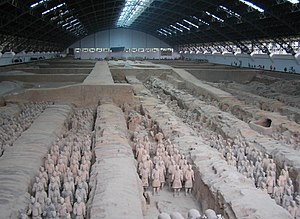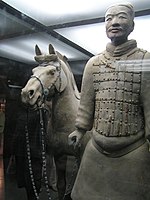Terracotta Army
| UNESCO World Heritage Site | |
|---|---|
 | |
| Criteria | Cultural: i, iii, iv, vi |
| Reference | 441 |
| Inscription | 1987 (11th Session) |
The Terracotta Army (simplified Chinese: 兵马俑; traditional Chinese: 兵馬俑; pinyin: bīngmǎ yǒng; lit. 'soldier and horse funerary statues') are the Terracotta Warriors and Horses of Shi Huang Di the First Emperor of China. The terracotta figures, dating from 210 BC, were discovered in 1974 by several local farmers near Xi'an, Shaanxi province, China near the Mausoleum of the First Qin Emperor (Chinese: 秦始皇陵; pinyin: Qín Shǐhuáng Líng). The figures vary in height (184–197cm - 6ft–6ft 5in), according to their role, the tallest being the Generals. The figures include warriors, chariots, horses, officials, acrobats, strongmen, and musicians. Current estimates are that in the three pits containing the Terracotta Army there were over 8,000 soldiers, 130 chariots with 520 horses and 150 cavalry horses, the majority still buried in the pits.[1]
Introduction


The Terracotta Army is a form of funerary art buried with the Emperor of Qin (Shi Huangdi) in 209-210 BC (his reign over Qin was from 247 BC to 221 BC and unified China from 221 BC to the end of his life in 210 BC). Their purpose was to help rule another empire with Shi Huang Di in the afterlife. Consequently, they are also sometimes referred to as "Qin's Armies". Some people think that the army was also built for protection.
The Terracotta Army was discovered in March 1974 by local farmers drilling a water well to the east of Lishan (Mount Li).[2] Mount Li is also where the material to make the terracotta warriors originated. In addition to the warriors, an entire man-made necropolis for the emperor has been excavated.
According to the historian Sima Qian (145 BC-90 BC) construction of this mausoleum began in 246 BC and involved 700,000 workers. Sima Qian, writing a century after its completion, wrote that the First Emperor was buried with palaces, scenic towers, officials, valuable utensils and 'wonderful objects', with 100 rivers fashioned in mercury and above this heavenly bodies below which he wrote were 'the features of the earth'. Some translations of this passage refer to 'models' or 'imitations' but in fact he does not use those words. [3] Recent scientific work at the site has shown high levels of mercury in the soil of Mount Lishan, appearing to add credence to the writing of ancient historian Sima Qian.The tomb of Shi Huang Di is near an earthen pyramid 76 meters tall and nearly 350 square meters. The tomb remains unopened, in the hope that it will remain intact. Only a portion of the site is presently excavated.[4]

Qin Shi Huangdi’s necropolis complex was constructed to serve as an imperial compound or palace. It comprises several offices, halls and other structures and is surrounded by a wall with gateway entrances. The remains of the craftsmen working in the tomb have also been found within its confines, and it is believed they were sealed inside alive to prevent them from divulging information about the tombs.
In 2007 Chinese archaeologists, using remote sensing technology, located a 30 meter high building buried above the main portion of the tomb. It appears to have four large stair-like walls. Although one of the archaeologists, Duan Qingbo, suggests that it may have been built to aid the departure of the Emperor's soul, another expert, Chen Jingyuan, questioned the nature of the discovery. He suggested that speculating as to the findings' purpose might cause complicatons for future archeologists. [5]
Of note is that fact that the terracotta soldiers are life sized and that no two are alike. Most researchers believe that each statue is based on an actual soldier of that time.
Construction

The terracotta figures were manufactured both in workshops by government labourers and also by local craftsmen. The head, arms, legs and torsos were created separately and then assembled. Studies show that eight face moulds were most likely used and then the clay was added to give them individual facial features.[6] Once assembled the intricate features such as facial expressions were added. It is believed that their legs were made in much the same way that terracotta drainage pipes were manufactured at the time. This would make it an assembly line style of production, with specific parts manufactured and assembled after being fired as opposed to crafting one solid piece of terracotta and subsequently firing it. In those days, each workshop was required to inscribe its name on items produced so as to ensure quality control; this has aided modern day historians in verifying that workshops that once made tiles and other every day items were commandeered to work on the terracotta army. Upon completion, the terracotta figures were placed in the pits outlined above in precise military formation according to rank and duty.
The terracotta figures are life-like and life-sized. They vary in height, uniform and hairstyle in accordance with rank. The colored lacquer finish, individual facial features, and replica weapons and armor used in manufacturing these figures created a realistic appearance. The original weapons were stolen shortly after the creation of the army and the coloring has faded greatly. However, their existence serves as a testament to the amount of labour and skill involved in their construction. It is also a confirmation of the power the First Emperor possessed that enabled him to command such a monumental undertaking as this army's manufacture.
The Pits
The four pits associated with the figures are about 1.5km east of the burial mound and are about 5 meters deep.They are outside the walls of the tomb complex as if placed there to guard the tomb from attack from the east, where all the conquered states lay. They are solidly built with rammed earth walls and ground layers as hard as concrete. Pit 1, 230 meters long, contains the main army, estimated at 6000 figures. Pit One has 11 corridors, most of which are over 3 meters wide, and paved with small bricks with a wooden ceiling supported by large beams and posts. This design was also used for the tombs of noblemen and would have resembled palace hallways. The wooden ceilings were covered with reed mats and layers of clay for waterproofing and then mounded with more soil making them when built about 2 to 3 meters higher than the ground level.[7] Pit 2 has cavalry and infantry units as well as war chariots, and is thought to represent a military guard. Pit 3 is the command post, with high ranking officers and a war chariot. Pit 4 is empty, seemingly left unfinished by its builders.
Destruction and gradual decay

There is evidence of a large fire that burned the wooden structures that once housed the Terracotta Army. It was described by Sima Qian, who said that the fire was a consequence of a raid on the tomb by General Xiang Yu less than five years after the death of the First Emperor. According to Sima Qian, General Xiang’s army looted the tomb and the structures holding the Terracotta Army, as well as setting fire to the necropolis and starting a blaze that allegedly lasted three months (though no other recorded great fire in history ever lasted more than seven days). Because of this, only one statue has survived intact: a statue of a kneeling archer. Despite the fire, however, much of the remains of the Terracotta Army still survives in various stages of preservation, surrounded by remnants of the burnt wooden structures.
In 1999, it was reported that the warriors were suffering from "nine different kinds of mold", caused by raised temperatures and humidity in the building which houses the soldiers, and by the breath of tourists.[8] In addition, the South China Morning Post reported that the figures have become oxidised grey from being exposed to the air, which may cause arms to fall off, and noses and hairstyles to disappear. [9] However, officials have dismissed these claims.[10] In Daily Planet Goes to China, the Terracotta Warriors segment reported that the Chinese scientists found soot on the surface of the statue, concluding that the pollution introduced from coal burning plants was responsible for the decaying of the terracotta statues.
Gallery
-
The warriors were once highly coloured
Notes
- ^ Jane Portal and Qingbo Duan, The First Emperor: China's Terracotta Arm, British Museum Press, 2007, p. 167
- ^ The precise coordinates are 34°23′5.71″N 109°16′23.19″E / 34.3849194°N 109.2731083°E)
- ^ Jane Portal and Qingbo Duan, The First Emperor: China's Terracotta Arm, British Museum Press, 2007, p. 17
- ^ The Mausoleum of the First Emperor of the Qin Dynasty and Terracotta Warriors and Horses
- ^ 30m building within Emperor Qin's tomb?
- ^ Jane Portal and Qingbo Duan, The First Emperor: China's Terracotta Arm, British Museum Press, 2007, p. 170
- ^ Jane Portal and Qingbo Duan, The First Emperor: China's Terracotta Arm, British Museum Press, 2007, pp260-167
- ^ World: Asia-Pacific Pollution threat to terracotta army
- ^ Air pollution harms terracotta warriors
- ^ Is the terracotta army in danger?
Bibliography
- Debainne-Francfort, Corrine. "The Search for Ancient China," (Harry N. Abrams Inc. Pub. 1999): 91-99.
- Dillon, Michael(ed). "China: A Cultural and Historical Dictionary," (Curzon Press, 1998): 196.
- Ledderose, Lothar. "A Magic Army for the Emperor." from "Ten Thousand Things : Module and Mass Production in Chinese Art" ed. Lothar Ledderose, (Princeton UP, 2000): 51-73.
- Perkins, Dorothy. "Encyclopedia of China: The Essential Reference to China, Its History and Culture," (Roundtable Press, 1999): 517-518.
- Portal (ed.), Jane (2007). The First Emperor: China's Terracotta Army. British Museum Press. ISBN 9780714124476.
{{cite book}}:|last=has generic name (help) - Richards, Jack C. Interchange 2, Third Edition, (Cambridge University Press, 2005):80.
- Macmanus, Caitlyn. Oxford University specialty in China's history.






